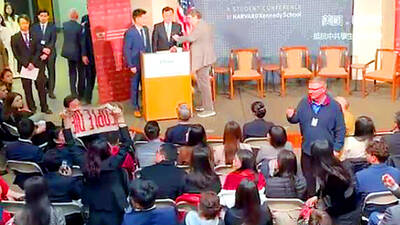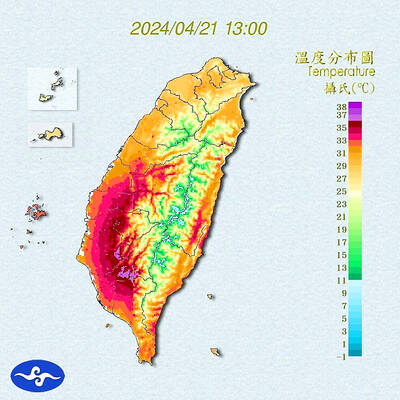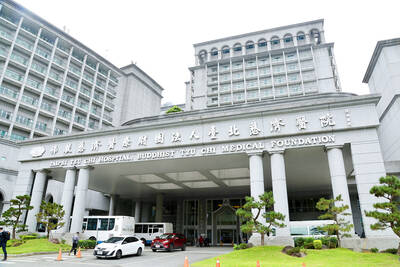The Chinese Nationalist Party (KMT) and President Ma Ying-jeou’s (馬英九) repeated citing of the Cairo Declaration and the Potsdam Declaration as proof that Taiwan’s sovereignty belongs to the Republic of China (ROC) ignores the historical context of those documents and the development of international status, pro-independence advocates said yesterday.
“Taiwan’s status under international law should be based on the Treaty of San Francisco, in which Japan renounced its sovereignty over Formosa (Taiwan) and the Pescadores (Penghu), but never said which country Taiwan belonged to,” former Academia Historica president Chang Yen-hsien (張炎憲) told a seminar held to revisit the treaty signed in 1951.
Generalissimo Chiang Kai-shek (蔣介石) was invited to join then-US president Franklin Roosevelt and then-British prime minister Winston Churchill in Cairo, where the clause that proposed to return Taiwan and the Pescadores to the ROC was added to the declaration to force Chiang Kai-shek to “stay in the battle” because he was said to be considering signing a peace treaty with Japan at the time, Chang Yen-hsien said.
If Chiang Kai-shek had done so, it would have created pressure on the Allied forces which were fighting Germany in Europe because Japanese troops could have joined the European battlegrounds, he added.
While the Potsdam Declaration used the same rhetoric of the Cairo Declaration in terms of Taiwan’s future, they were wartime documents and when the Korean War broke out, then-US president Harry Truman was forced to reconsider Taiwan’s status, which he later said remained undetermined, Chang added.
Ma’s citing of those documents fails to address the changing international political dynamics and the fact that Japan has never transferred Taiwan’s sovereignty to any country, Chang added.
Historian Lee Hsiao-feng (李筱峰) said that the US and UK expressed opposition in 1946 to the KMT regime’s unilateral decision to “restore ROC nationality in Taiwan” because the Chiang Kai-shek administration was only performing a UN order for a temporary military occupation of Taiwan.
Lee added that, regardless of how the Treaty of San Francisco and the Treaty of Taipei — which was signed in 1952 between Japan and the ROC government — were interpreted, one thing is sure: Taiwan has never been part of the People’s Republic of China’s territory.
“That is why Taiwanese should be very concerned about Ma’s political identity, which has always been a ‘one China’ identity,” Lee said.
Many policies and advocacies of Ma’s political career are solid evidence of his ‘one China’ belief, such as his insistence on the implementation of Hanyu Pinyin for Mandarin, diplomatic truce, his refusal of US military assistance during Typhoon Morakot in 2009 and Taiwan’s participation in the World Health Assembly as a province of China, among others.
“Ma had those policies and positions because of one reason — his China-centric historical view. He always interpreted international politics and domestic affairs as a Chinese rather than a Taiwanese,” Lee said.
“I would say that is the biggest threat for Taiwanese right now,” he said.

A group of Taiwanese-American and Tibetan-American students at Harvard University on Saturday disrupted Chinese Ambassador to the US Xie Feng’s (謝鋒) speech at the school, accusing him of being responsible for numerous human rights violations. Four students — two Taiwanese Americans and two from Tibet — held up banners inside a conference hall where Xie was delivering a speech at the opening ceremony of the Harvard Kennedy School China Conference 2024. In a video clip provided by the Coalition of Students Resisting the CCP (Chinese Communist Party), Taiwanese-American Cosette Wu (吳亭樺) and Tibetan-American Tsering Yangchen are seen holding banners that together read:

UNAWARE: Many people sit for long hours every day and eat unhealthy foods, putting them at greater risk of developing one of the ‘three highs,’ an expert said More than 30 percent of adults aged 40 or older who underwent a government-funded health exam were unaware they had at least one of the “three highs” — high blood pressure, high blood lipids or high blood sugar, the Health Promotion Administration (HPA) said yesterday. Among adults aged 40 or older who said they did not have any of the “three highs” before taking the health exam, more than 30 percent were found to have at least one of them, Adult Preventive Health Examination Service data from 2022 showed. People with long-term medical conditions such as hypertension or diabetes usually do not

Heat advisories were in effect for nine administrative regions yesterday afternoon as warm southwesterly winds pushed temperatures above 38°C in parts of southern Taiwan, the Central Weather Administration (CWA) said. As of 3:30pm yesterday, Tainan’s Yujing District (玉井) had recorded the day’s highest temperature of 39.7°C, though the measurement will not be included in Taiwan’s official heat records since Yujing is an automatic rather than manually operated weather station, the CWA said. Highs recorded in other areas were 38.7°C in Kaohsiung’s Neimen District (內門), 38.2°C in Chiayi City and 38.1°C in Pingtung’s Sandimen Township (三地門), CWA data showed. The spell of scorching

POLICE INVESTIGATING: A man said he quit his job as a nurse at Taipei Tzu Chi Hospital as he had been ‘disgusted’ by the behavior of his colleagues A man yesterday morning wrote online that he had witnessed nurses taking photographs and touching anesthetized patients inappropriately in Taipei Tzu Chi Hospital’s operating theaters. The man surnamed Huang (黃) wrote on the Professional Technology Temple bulletin board that during his six-month stint as a nurse at the hospital, he had seen nurses taking pictures of patients, including of their private parts, after they were anesthetized. Some nurses had also touched patients inappropriately and children were among those photographed, he said. Huang said this “disgusted” him “so much” that “he felt the need to reveal these unethical acts in the operating theater